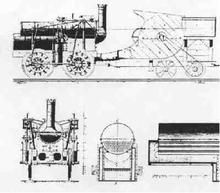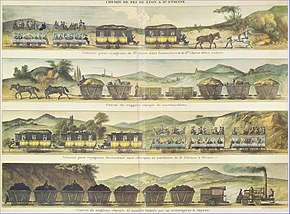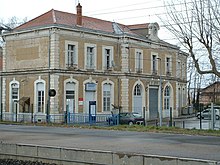Saint-Étienne – Lyon railway line
| Saint-Etienne-Lyon | |||||||||||||||||||||||||||||||||||||||||||||||||||||||||||||||||||||||||||||||||||||||||||||||||
|---|---|---|---|---|---|---|---|---|---|---|---|---|---|---|---|---|---|---|---|---|---|---|---|---|---|---|---|---|---|---|---|---|---|---|---|---|---|---|---|---|---|---|---|---|---|---|---|---|---|---|---|---|---|---|---|---|---|---|---|---|---|---|---|---|---|---|---|---|---|---|---|---|---|---|---|---|---|---|---|---|---|---|---|---|---|---|---|---|---|---|---|---|---|---|---|---|---|
|
Route chain Lyon – Saint-Étienne – Andrézieux – Roanne
(since 1833) and planned route Chalons – Lyon in 1849 | |||||||||||||||||||||||||||||||||||||||||||||||||||||||||||||||||||||||||||||||||||||||||||||||||
| Route number (SNCF) : | 750,000 | ||||||||||||||||||||||||||||||||||||||||||||||||||||||||||||||||||||||||||||||||||||||||||||||||
| Route length: | 58 km | ||||||||||||||||||||||||||||||||||||||||||||||||||||||||||||||||||||||||||||||||||||||||||||||||
| Gauge : | 1435 mm ( standard gauge ) | ||||||||||||||||||||||||||||||||||||||||||||||||||||||||||||||||||||||||||||||||||||||||||||||||
| Power system : | 1.5 kV = | ||||||||||||||||||||||||||||||||||||||||||||||||||||||||||||||||||||||||||||||||||||||||||||||||
| Dual track : | Saint-Etienne-Lyon | ||||||||||||||||||||||||||||||||||||||||||||||||||||||||||||||||||||||||||||||||||||||||||||||||
|
The tunnel lengths reflect the current state. Upper number: today's mileage; Lower: historical.
|
|||||||||||||||||||||||||||||||||||||||||||||||||||||||||||||||||||||||||||||||||||||||||||||||||
The Saint-Étienne – Lyon railway is a 58 kilometer long railway line in France . It was built from 1827 to 1832 under the direction of the engineer Marc Seguin , who was a partner in the railway company with Édouard Biot . The line was the second railway line on the European mainland that was also used for passenger transport and the first to be operated with steam power.
history
Saint-Étienne – Lyon was the second licensed railway line in France at all and also the second in Saint-Étienne. On March 27, 1826, the Compagnie du chemin de fer de Saint-Étienne à Lyon was founded to build and operate the line and after the completion of the approval process on March 27, 1827, construction work began.
The line was put into operation in three sections, the third of which was technically the most difficult, but crucial for the decision to build the railway. On the section between Givors and Rive-de-Gier , which was put into operation on June 28, 1830, steam operation began in 1831 with the Seguin locomotive , and regular passenger traffic began in the same year. Nevertheless, the railway was mainly operated as a horse-drawn railway for many months , the horses were transported downhill on a cattle wagon. The section from Givors to Lyon went into operation on April 3, 1832, initially only for freight transport. The route from Rive-de-Gier to Saint-Étienne was initially only started for passenger transport on October 1, 1832. From April 4, 1833, people and goods were transported along its entire length.
In 1834 or 1835, Seguin left the company because of differences of opinion.
The journey time for the entire 58 kilometers was six hours in 1836, at which time 12 locomotives and 135 wagons were used between 1829 and 1834. There have always been accidents because the route has not yet been effectively kept clear of passers-by. Since 1844 no horses have been used except in shunting operations. At that time the journey only took 2½ hours.
The line has belonged to the French state railway SNCF since 1938 and was electrified in 1957. Today it is used by all types of train, including the TGV . The travel time of the regional trains from Saint-Étienne Châteaucreux to Lyon Perrache is 50 minutes.
route
Original route sections
Saint-Étienne was a center of coal mining and is considered the cradle of French heavy industry. It is located in a mountainous area on the watershed between the Rhone and Loire , around 300 meters higher than the confluence of the Saône and Rhône near Lyon, the third largest city in France.
The long construction period of five years can be explained by the sometimes difficult terrain. A bridge over the Saône had to be built in Oullins . Several tunnels were dug in the upper part of the route, the longest 1.5 km, 1 km and 400 m long. It was thus possible to keep the gradient between Saint-Étienne and Rive-de-Gier between 12 and 14 ‰, on the next section, which was already parallel to Gier , at 6.5 ‰. The route between Givors and Lyon (parallel to the Rhône) is flat; this section was expanded to double-track in the early days.
The link with the Saint-Étienne – Andrézieux railway , which was completed five years earlier, resulted in a network length of 69.8 km. A year later, the Roanne – Andrézieux railway was connected to the penultimate station on that route . The length of the line between the most distant stations of the resulting network was 139.7 km, the length of the network including sections of the line extending beyond the transition stations was 145.2 km.
Younger sections of the route
In the further course of time the line was branched in the metropolitan area of Lyon. The additional stations were built there
- Lyon-Part-Dieu
- Lyon-Vaise
Locomotives
The engineer and partner Marc Seguin had found out about the state of the art in England and bought two locomotives from George Stephenson's Locomotion type . But they turned out to be too weak and too difficult for the gradients to be mastered on its route. So he set about designing lighter and stronger locomotives and has been doing test drives with them since 1829. In doing so, he installed various boilers on a trial basis, the most powerful of which he then used for train operations.
From 1831 the Seguin locomotive was actually harnessed to trains, the first steam-powered train operation on the European continent. With this and another locomotive, he let the steam escape into the open after the expansion in the cylinder. To kindle the fire under the boiler, a large fan was mounted on the tender, which was driven by the rotation of the tender's running wheels with a kind of V-belt.
By 1834 Seguin built ten more locomotives for the Saint-Étienne – Lyon railway. With them, however, as then with English and later all steam locomotives, the air flow through the fire box was accelerated by introducing the escaping steam into the chimney. The first two locomotives were also converted to this effect.
The steep section from Rive-de-Gier to Saint-Étienne was not mastered by locomotives until 1844.
Incidents
On September 21, 1945, a serious rail accident occurred near Vernaison when two trains collided. 30 people died, 105 were also injured.
See also
Web links
- Information about the route on trains.wikia.com (French)
- Information about the route on fr.structurae.de (French)
- Information about Marc Seguin (French)
- History of the first French railways (French)
- The first railway lines around Saint-Étienne and their implementation as a model railway (French)
- The industrial revolution in Saint-Étienne (French)
Individual evidence
- ^ Peter WB Semmens: Catastrophes on rails. A worldwide documentation. Transpress, Stuttgart 1996, ISBN 3-344-71030-3 , p. 116.




